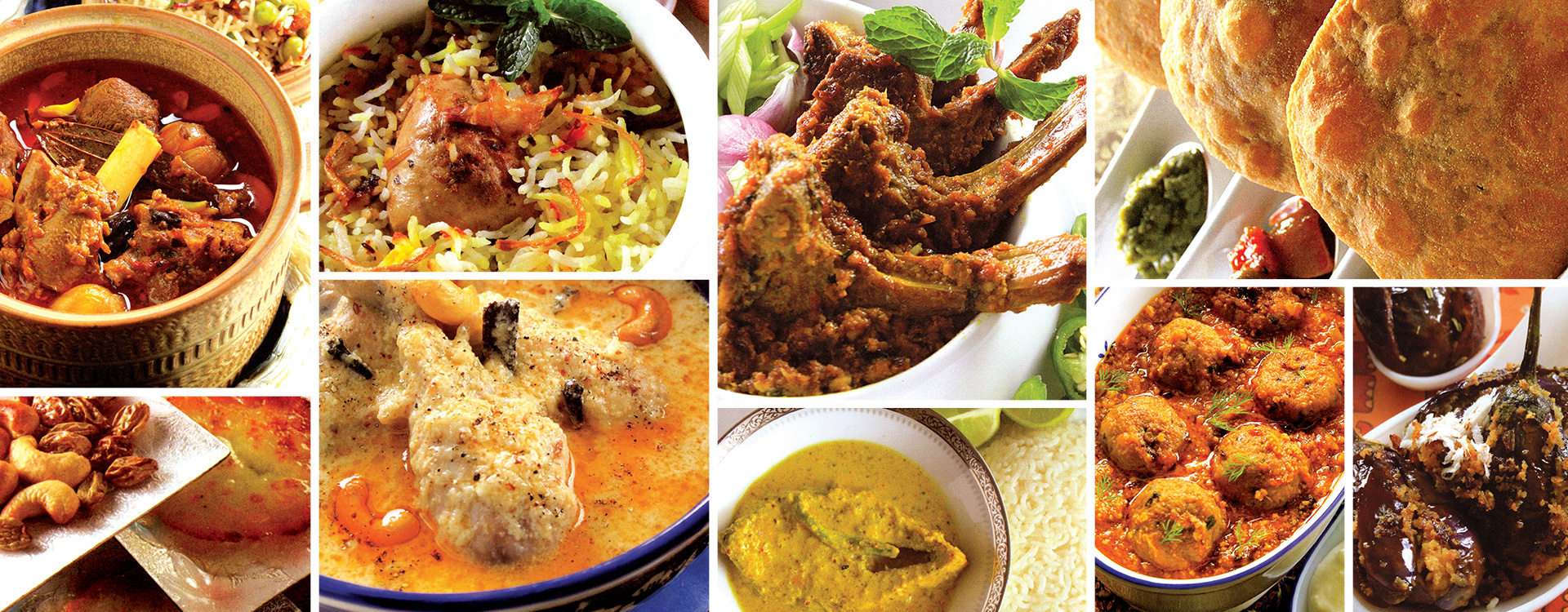Kayasth Cuisine
What can the Bachchans, Amitabh Ghosh, Jishnu Baruah, Todar Mal, Udhav Thackeray, Shatrughan Sinha, Lal Bahadur Shastri, Navin Patnaik, Venkaiah Naidu, Kajol, and Madhur Jaffrey possibly have in common? They are all Kayasthas. From surnames in the north (Mathur, Shrivastava, and the like) to the south (Naidu, Mudaliar, and the like) to the East (Ghosh, Mallik, et al) are Kayasthas and that they all are great connoisseurs of food. So what is unique about cuisines among Kayasthas? Answer to this question comes from outstanding cook books and kitchens of Kayasth cuisine experts like Preeta Mathur, Anoothi Vishal, Sugandha Saxena, Smita Verma, Rashmi Sinha, Samir Gupte, and Sushma Deshpandey.
Most elements of Kayastha cuisine are truly representative of a syncretic culture marked by fusion and assimilation. They originated from the myriad of conquerors through the ages: the Parthians, Turks, Afghans, Mughals, and the British, who left their imprint in the form of cuisine. The adaptability in cuisines show up even today in the regional variations of Kayasth kitchens broadly in Hindi heartland, Maharashtra, Tamil Nadu, and Bengal.
Proximity to royal kitchens however reflect as an underlying thread in the Kayasth cooking techniques. Bhuna (slow-roasting), dum (steam-cooking), and dhungar (smoke-cooking) are three common cooking techniques of Kayasthas applied equally to vegetarian and non-vegetarian Kayasth cooking. Judicious usage of Garam Masala however plays the referee's role in the finalreckoning.
In Dum cooking, after the cooking is over, the heavy bottomed pan is tightly covered and sealed all along the rim with a flour dough. A few cinders are placed on the lid and the pan placed on a very slow fire. The heat from the sides acts as an oven. Alternatively, the pan can be covered with an aluminium foil and placed on the griddle to avoid direct heat.
Bhuna, to put it simply, is to stir-fry at low heat. This quintessential process imparts the fully integrated richness of all the masalas used in that preparation. In a heavy-bottomed pan, oil is heated and the masalas are painstakingly cooked till the oil and the masalas separate. During this process, water is sprinkled intermittently to ensure that the masalas do not burn or stick to the bottom while stirring it with the aid of a long and sharp-ended spoon called a khurchani.
Dhungar infuses the food being cooked with a smoky flavour. For that, 2 - 3 live pieces of charcoal are placed in a small steel bowl (katori) or on an onion peel or cabbage leaf. Two to four cloves with a few drops of ghee are placed on it. When it begins to smoke, it is placed inside the receptacle containing the food and immediately covered with a lid. The trapped smoke permeates the food imparting it with a delightful smoky flavour. Dhungar is given to raw kababs, biryanis, raitas, pasandas, and the like.
With the coming of the British, their lifestyle of Kayasthas once more underwent changes. Drinking bed tea from fine porcelain cups to eating at a dining table and drinking wine or whisky each evening, became a customary ritual in Kayastha homes. So entrenched did this customary ritual become that today it is difficult to imagine any Kayastha khana without peena, shami kebab without an accompanying peg of scotch whisky.
Given the Kayastha community’s obsession with good food, meal times have traditionally been essential social occasions. Families sit together, chat, laugh, sing, perhaps have a drink or two. They make merry and generate warmth and togetherness, and share family gossip over a generously laid out table of inviting dishes. Earlier, Kayastha joint family homes had two separate kitchens for vegetarian and non-vegetarian preparations.
Although many Kayastha women are vegetarians, they can turn out both vegetarian and non-vegetarian dishes with equal aplomb. As culinary artists, they can cook and present vegetarian dishes to resemble non-vegetarian ones, be it dal kaleji, dal keema matar, bhuna kathal (jack fruit), kathal kabab, bhuna zimikand (elephant foot), potato Ishtu, black gram shami kabab, and vegetables like bitter, round, wax bottle gourd, and okra which can rival the finest non-vegetarian dishes.
Delicious, filling meals are topped up with a tasty and wide variety of delicious sweetmeats such as kheer, halwas, barfis, malpua, shahi tukda, rabri, jalebis, pista and almond lauz, khurchan, firni, parwal-ki-mithai, and double-ka-meetha. Special mention must be made of the exquisite sweet celebrated as daulat-ki-chaat, also called nimish. Here, boiled, thick cooled milk is mixed with sugar, rose water, and saffron, and is left uncovered or covered by a fine muslin cloth, out in the cold winter night to infuse the dew. In the morning, it is repeatedly churned and the foam collected in shakoras (small earthen bowls). This is garnished with dry fruits and then served.


 Media
Media